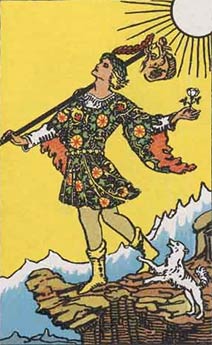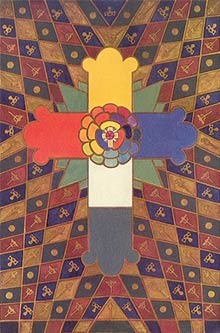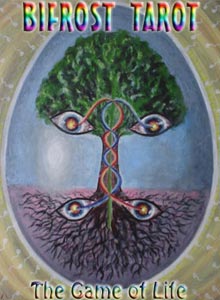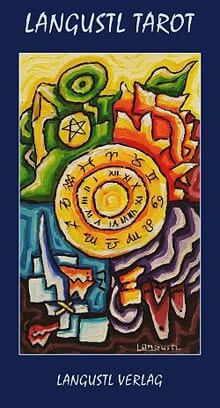Discover and study complete tarot deck galleries featuring the Surrealist Tarot, Diary of a Broken Soul, bifrost Tarot, and Langustl Tarot. Each of these unique tarot decks offers its own visual language and symbolic system, reflecting the artist’s interpretation of classic esoteric traditions. As dedicated tarot smiths, our work centers on the art of tarot cards, their structure, and the deeper symbolism within each deck—from the Major Arcana’s archetypes to the subtle storytelling of the Minor Arcana.
If you wish to experience these cards in action, you can do a tarot reading directly on Tarotsmith. We also provide readings with two of the most iconic tarot decks of all time—the Rider-Waite and and the Crowley-Thoth.
The Rider–Waite–Smith (RWS) deck remains the most widely used tarot deck for beginners and professionals alike. Having sold more copies than any other deck in history, it has inspired countless RWS-style tarot decks, reinterpretations, and modern clones. Its clear imagery makes it easy to learn and use without extensive study of occult systems. The illustrated Minor Arcana replaced traditional pip cards with vivid narrative scenes, simplifying intuitive reading and making symbolic meanings accessible to everyone. By emphasising cartomancy reversals over complex elemental dignities, the RWS opened the door for a new generation of tarot readers who value clarity and directness in interpretation.
Today, the Rider-Waite deck serves as the foundation for understanding modern tarot symbolism. Whether you are studying tarot meanings, exploring esoteric imagery, or comparing the visual storytelling styles of different artists, the Rider–Waite remains the reference point through which most readers first connect with the ancient language of tarot.
Each deck on Tarotsmith has its own website where you can read about the meanings of every card. Click the card images below to visit each deck’s LWB (little white book) website.
Rider–Waite Tarot
by A. E. Waite & Pamela Colman Smith
The Rider–Waite Tarot deck, first published in 1909, remains the foundation of most modern tarot decks. Designed by Arthur Edward Waite and illustrated by Pamela Colman Smith, this revolutionary tarot deck departed from earlier esoteric designs by presenting fully illustrated Minor Arcana, each card telling its own story through symbolic scenes. The result was a tarot system that brought mystical teachings into visual clarity—accessible both to novices and seasoned occultists.
Rooted in Golden Dawn symbolism, the Rider–Waite combines Kabbalistic structure, Christian mysticism, and astrological archetypes into a unified visual grammar. The Major Arcana charts the soul’s journey from innocence to enlightenment, while the Minor Arcana captures the rhythms of daily life—its victories, failures, labours, and joys.
For over a century, the Rider–Waite–Smith deck has served as the template for countless other tarot decks, including many featured on Tarotsmith. It remains the most popular tarot deck for beginners, as well as a timeless reference point for those studying tarot symbolism, divination, and the psychological meaning behind archetypal imagery.
The Book of Thoth
by Aleister Crowley & Lady Frieda Harris
The Thoth Tarot deck, conceived by Aleister Crowley and painted by Lady Frieda Harris between 1938 and 1943, represents one of the most intricate and philosophically charged tarot decks ever created. Originally published with Crowley’s seminal text, The Book of Thoth, this deck distils the entirety of Golden Dawn magick, Kabbalah, astrology, alchemy, and Egyptian mythology into a dense, radiant symbolic system.
Each card of the Thoth deck is a meditation in colour, geometry, and occult meaning. Harris’s art translates Crowley’s complex metaphysical teachings into visual form—dynamic, abstract, and vibrantly alive. The deck renames and reimagines several traditional cards, shifting the emphasis toward transformation, will, and spiritual awakening.
Though challenging to master, the Book of Thoth Tarot remains a cornerstone for students of esoteric tarot and occult philosophy. Its depth rewards those willing to engage its layered symbolism and internal correspondences. Many modern tarot readers and deck creators still draw upon Crowley’s visionary framework, making the Thoth Tarot one of the most studied and influential tarot decks in history.
Surrealist Tarot
by Ari Bach
The Surrealist Tarot is an unorthodox deck structured around a set of 12 core Majors based on the LaVey Personality Synthesizer. The LPS is a system of classifying personality types similar to using astrology, but more basic and practical. Instead, the LPS uses criteria such as mentality, body type, and ego (demonstrated by choice of automobiles). This deck’s quirky style of humour invokes images reminiscent of everything from Star Trek to Super Mario Bros.
Diary of a Broken Soul
by Ash Abdullah
The Diary of a Broken Soul is a gateway to the dimension of Jahanam, rendered from the visions of Ash Abdullah’s three-year soul quest. Jahanam is a mysterious world that shadows the mundane view of reality. In Jahanam, thoughts and ideas are tangible and emotions have faces. The sublime Diary documents personal exploration and therapy, encouraging the often painful process of probing the unconscious mind to find and face one’s deepest fears.
The text for the (e)LWB and the key phrases for Diary‘s online readings (for the Minor Arcana) was written by Davina Powell. Also, the full deck contains a few alternate cards from the majors-only release.
bifrost Tarot
by Jeremy Lampkin
The bifrost (stylised lower case) Tarot is an occult deck rooted in Thoth/GD tradition, also influenced by the teachings of several of those who followed in Aleister Crowley’s footsteps, as well as mystical teachings from all through history. bifrost was designed for those who appreciate mystical traditions and new spiritual understandings (which often serve to undermine one’s convictions). Despite having modernised and easy to recognise symbolism, the nature of bifrost’s rich occult depth may make it potentially difficult for beginners. Those who are not prepared to deal with uncomfortable revelations may not want to use this deck, as it is intended to be used to break down the psyche, and therefore can cause major cognitive dissonance.
Langustl Tarot
by Stephan ‘Langustl’ Lange
The Langustl Tarot‘s simplistic style of art is vibrant with life, relying on brilliant colour and contrast to portray the feelings of each card. The deck is based on both Crowley’s and Waite’s tarot methods, along with other systems such as astrology, Kabbala, and numerology. While simple enough for beginners to easily interpret, the deck is also challenging for students to learn its deep layers of symbolism.
Rider–Waite vs. Thoth: The Two Pillars of Modern Tarot
Every modern tarot deck owes a debt to either the Rider–Waite–Smith or the Book of Thoth Tarot. These two systems stand as the twin pillars of twentieth-century tarot symbolism, each reflecting a distinct spiritual philosophy within the same Golden Dawn tradition.
The Rider–Waite Tarot simplifies and humanises the mysteries of the occult. Its illustrated scenes make intuitive reading possible even for beginners, translating mystical archetypes into stories anyone can relate to. It speaks in plain emotional language—joy, loss, ambition, faith—turning esoteric symbolism into direct human experience.
The Thoth Tarot, by contrast, dives into the deepest strata of Western esotericism. Every card in Crowley’s deck encodes layers of astrology, Kabbalah, and alchemy, presenting the tarot not as fortune-telling, but as a complete initiatory map of consciousness. Where Rider–Waite teaches through narrative, Thoth teaches through revelation.
Together, these two tarot decks define the foundation of modern practice: Waite’s deck teaches readers how to see, and Crowley’s teaches them how to think. Most contemporary tarot readers, artists, and mystics draw from both—balancing accessibility with metaphysical depth. Whether you’re a new student seeking clarity or a seasoned magician decoding the language of symbols, mastery of the Rider–Waite and Thoth decks is the key to understanding the living current that animates all tarot cards.






